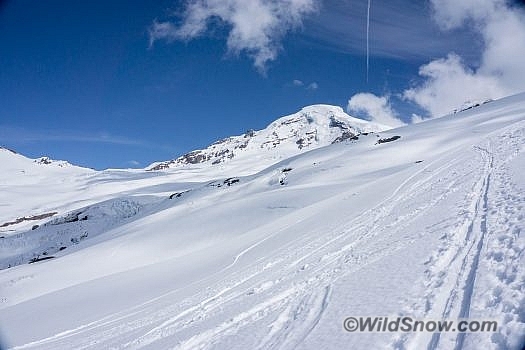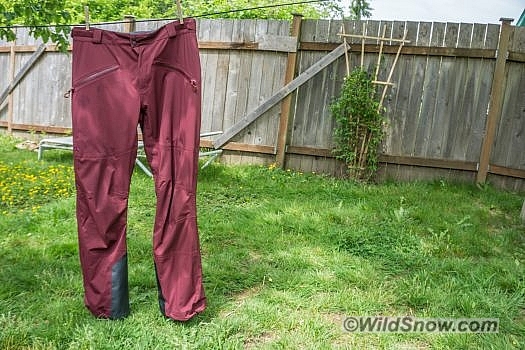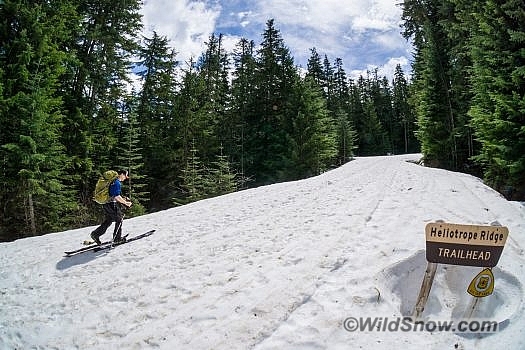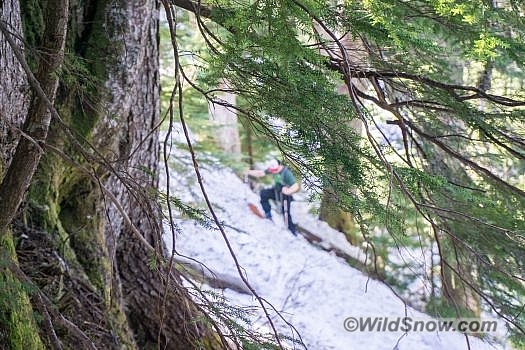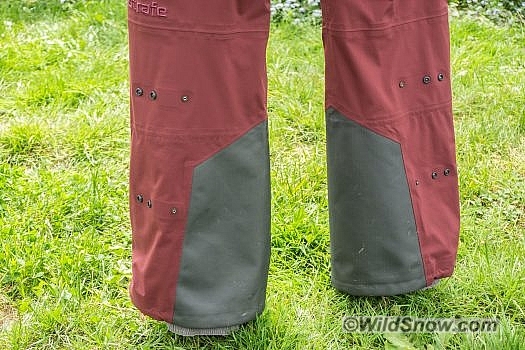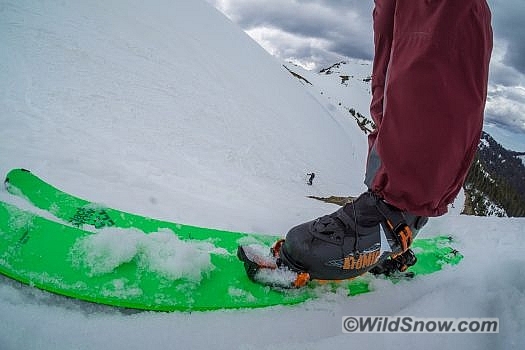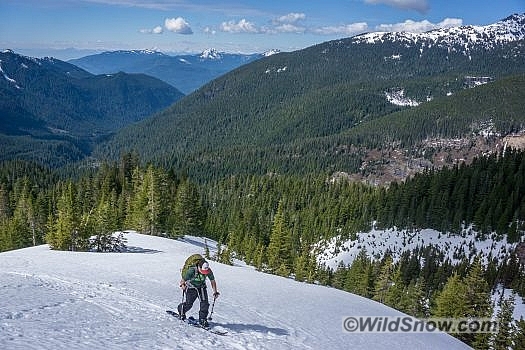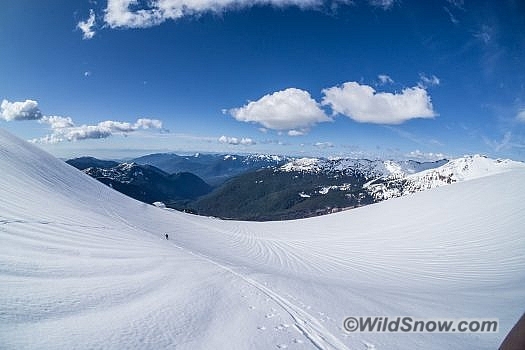Leif Whittaker
Editor’s note: The “Cham” jacket and pants are actually the third generation of the garments. This article originally referred to them as “Cham3” but we edited it to simply “Cham” since that is the official name of the third generation jacket and pants. We reviewed Cham2, the second generation, here.
The day we skinned up the Coleman Glacier everyone in Washington was thinking about summer. The checker at the grocery store, the barista at the coffee stand and the grizzled logger who pumped gas in the stall next to me, all commented on the record-setting heat. Women in bikinis lay next to the lake, soaking up rays like solar panels recharging dead batteries. Washingtonians had crossed a threshold. They had left winter behind and now rode optimistically into four months of utopian weather that would make the previous eight months of Vitamin D deficiency worth it. Snow was the last thing on any sane person’s mind, which is why the checker looked at me like I was crazy when I told her I was going on an expedition to Denali.
Sandwiches packed, brains caffeinated and gas tank full, my friend, Mike, and I drove into the North Cascades to punish our legs and test some of the gear we were planning to take to Alaska.
I was eager to try a new touring pant, the Cham Pant from Strafe. As the name implies, this is the third iteration of a pant Strafe has offered for several years. Updated for 2018 with new proprietary 4-way stretch Recon 3L fabric, they are marketed as lightweight, minimalist touring shells.
Out of the box, I noticed how supple and stretchy Cham felt, far different than the crinkly hard shells I’m used to. In fact, they felt more like soft shells, which was concerning given that I spend a lot of time in 33-degree “snain.” Would the Cham keep me dry on the wettest northwest afternoons? I was skeptical.
After two consecutive days skiing with the pantws inbounds and in the sidecountry at Mount Baker, I was thoroughly impressed. One day it was raining at the parking lot and snowing at the top of the lifts, yet my baselayer was dry when I retired to the tap room. The second day involved inbounds shredding on 10 inches of pow followed by a tour out the Shuksan Arm. The Cham kept me dry and comfortable in all these situations, although I still wondered if they would hold up to daily abuse.
Comprehensive guidebook for Backcountry Skiing Mount Baker here.
The real test was to use the pant for its intended purpose: extended tours and ski mountaineering. In other words, I wanted to know if they were suitable for a month-long expedition to Denali.
We parked on the edge of Glacier Creek Road more than a mile from Heliotrope Ridge trailhead. The surrounding forest was mostly green, but several feet of packed snow covered the road. Our objective was a 7200-foot knob of rock—known colloquially as “the lightning rod” that juts from the western boundary of Mount Baker’s Coleman Glacier. From the top of the rod, you can ski about 4000 vertical feet down the open bowls or narrow gullies (your choice!) of Grouse Creek drainage.
Within the first five minutes of uphill I was using the hamstring vents on the Cham pants. Thankfully, I wasn’t wearing long johns — only boxer briefs — and the interior fabric was amazingly comfortable next to my skin, much softer than traditional shells. I also noticed how breathable the pants were. On a day when bikinis were being worn at sea level, I never experienced that clammy feel you often get when you sweat beneath a shell.
The trail was partially melted out for the first few miles, so we had to take off our skis several times and boot up muddy sections. I appreciated the strong drawcord on the pant cuff, which wrapped snugly around my boots, keeping out snow and mud.
I also tried the plastic snap system on the calf that creates an even lower profile fit around the boot to prevent crampons catching on loose fabric. Though I wasn’t wearing crampons, this seemed like an unnecessary feature to me. The pants already offer a close, alpine-style fit and the small plastic snaps do not feel strong enough to hold the fabric together for extended periods in harsh conditions. A Velcro system might be better. Then again, the snaps are so tiny and thus easy to ignore.
Just below the site of the old Kulshan Cabin, at about 4500 feet, we were finally able to skin continuously. Kick turning up the drainage, we came to Hogsback Camp and the edge of the glacier. From there, we made an ascending traverse westerly, the afternoon sun in our faces and the broken seracs of the Coleman Headwall at our backs.
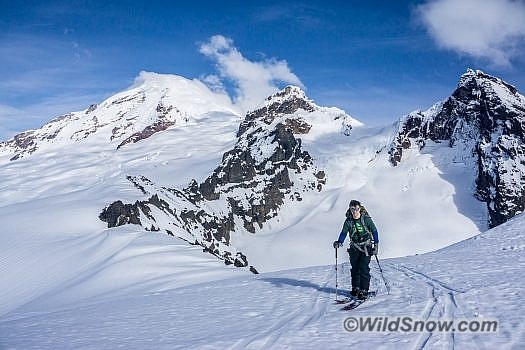
Mike nears the lightning rod with (left to right) Mount Baker, Colfax Peak, Lincoln Peak, and the Thunder Glacier in the background.
From the top of the ‘Rod, the first thousand feet of skiing was phenomenal, with fast and smooth corn leading us back toward tree line. Partway down, we laid tracks in a steep gully that neither of us had skied before. Then we were in the trees, jump-turning around deadfall and side-stepping over rushing creeks. We made it to the car without taking off our skis.
All in all, the Strafe pants performed well, and after several more trips in them — including a summit of Baker via the Coleman-Deming route — I’m confident they will be suitable for Denali, even if it is a little crazy to go there in the first place.
Strafe Outerwear on sale here. Cham will be available this fall.
(Born into a family of tall and loud mountaineers among the glaciated spires of the Olympic Mountains, guest blogger Leif Whittaker blames his lack of skiing talent on his high center of gravity. He has twice climbed to the summit of Mount Everest and he currently works as a climbing ranger for the USFS on Mount Baker. His first book, My Old Man and the Mountain, was published in October 2016 by Mountaineers Books. My Old Man and the Mountain: A Memoir)
Beyond our regular guest bloggers who have their own profiles, some of our one-timers end up being categorized under this generic profile. Once they do a few posts, we build a category. In any case, we sure appreciate ALL the WildSnow guest bloggers!

